2019 BMW F 850 GS Adventure
Following the unveiling of the recent BMW F 750 GS and F 850 GS, the new F 850 GS Adventure now expands the BMW Motorrad range in the adventure-touring segment.
Like the renowned boxer-engined BMW GS Adventure models, the new F 850 GS Adventures offers a dedicated travel enduro, for offroad oriented touring riders and globetrotters.
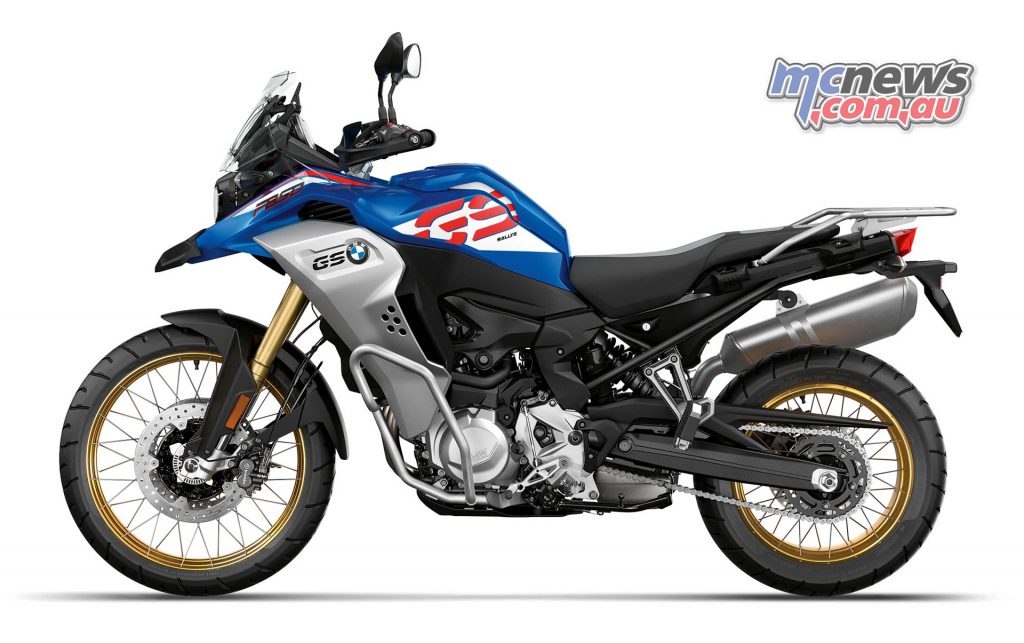
A new refined two-cylinder in-line engine with 90-degree crankpin offset and 270/450 degree ignition spacing incudes counterbalance shafts to reduce vibration. A slip-assist clutch provides a discernible reduction in lever effort.
The power transmission to the rear wheel comes from the six-speed gearbox with secondary drive that is now positioned on the left-hand side.
The new F 850 GS Adventure offers “Rain” and “Road” riding modes as standard, while the combination of BMW Motorrad ABS and the ASC automatic stability control ensure a high level of safety.
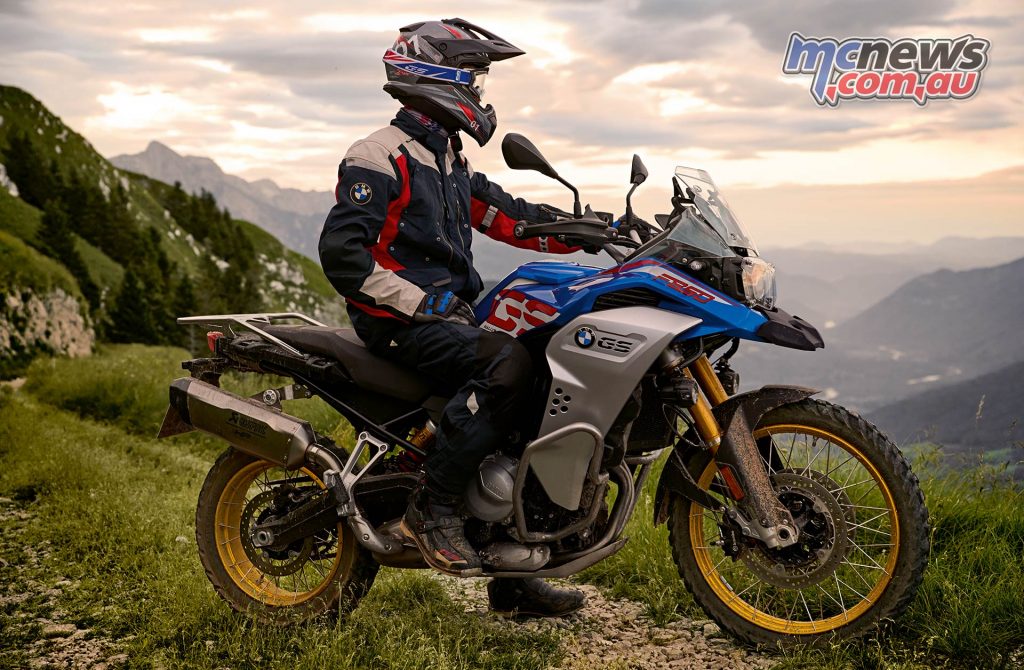
The F 850 GS Adventure can be fitted ex works with optional equipment, such as Pro Riding Modes and in turn the additional Dynamic, Enduro and Enduro Pro riding modes as well as the DTC dynamic traction control and lean-angle responsive ABS Pro.
The bridge frame of the new F 850 GS Adventure integrates the two-cylinder in-line engine as a supporting element of the backbone while the 23-litre fuel tank has been placed in the classic position between the seat and the steering head for an improved centre of gravity. BMW claim a touring range of 550 kilometres.
New, bodywork emphasises the F 850 GS Adventure’s more modern looks, with a larger adjustable windshield and hand-guards.
Wide enduro footrests, adjustable shift and foot brake levers as well as engine protection bars and a stainless steel luggage rack round off the F 850 GS Adventure’s standard equipment.
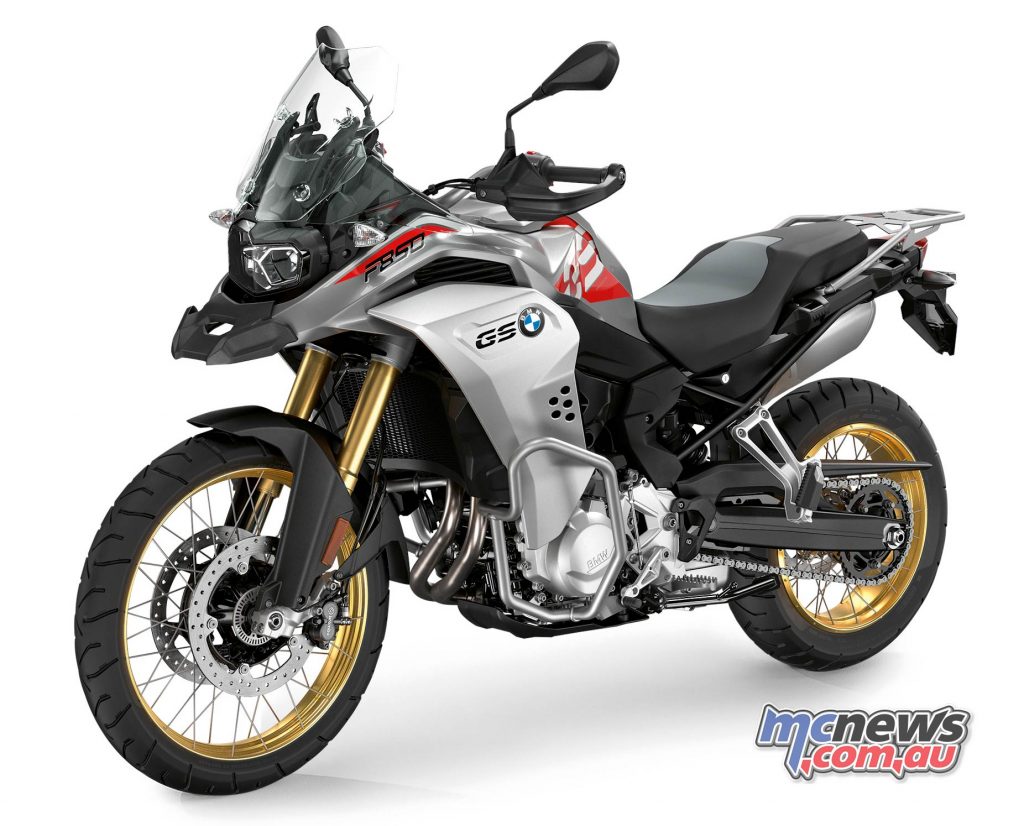
In addition to the basic version, the new F 850 GS Adventure is available in Exclusive and Rallye style variations.
2019 BMW F 850 GS Adventure highlights
- Powerful 2-cylinder in-line engine with a displacement of 853cc
- 70kW(95hp) at 8250rpm and 92Nm at 6250rpm
- Crankshaft with 90-degree crankpin offset and 270/450-degree ignition spacing
- New steel bridge frame
- New upside-down telescopic fork
- Aluminium two-sided swinging arm with central spring strut
- ABS, ASC and the riding modes “Rain” and “Road” as standard
- New onboard electrical system with more powerful alternator and starter
- LED headlamp as standard (DRL optional)
- Multi-functional instrument cluster (TFT optional)
- Optimised off-road and travel suitability
- Improved wind and weather protection – Adjustable screen
- 23 litre fuel tank for ranges up to 550 kilometres
- Enhanced GS Adventure profile
- New colour along with the two style variants Rallye and Exclusive
- Wide range of optional equipment and accessories
In-line, two-cylinder engine
The F 850 GS Adventure’s two-cylinder in-line engine has been completely re-engineered, with an aim to increase in power and torque compared to the previous models, as well as optimising combustion so as to reduce fuel consumption.
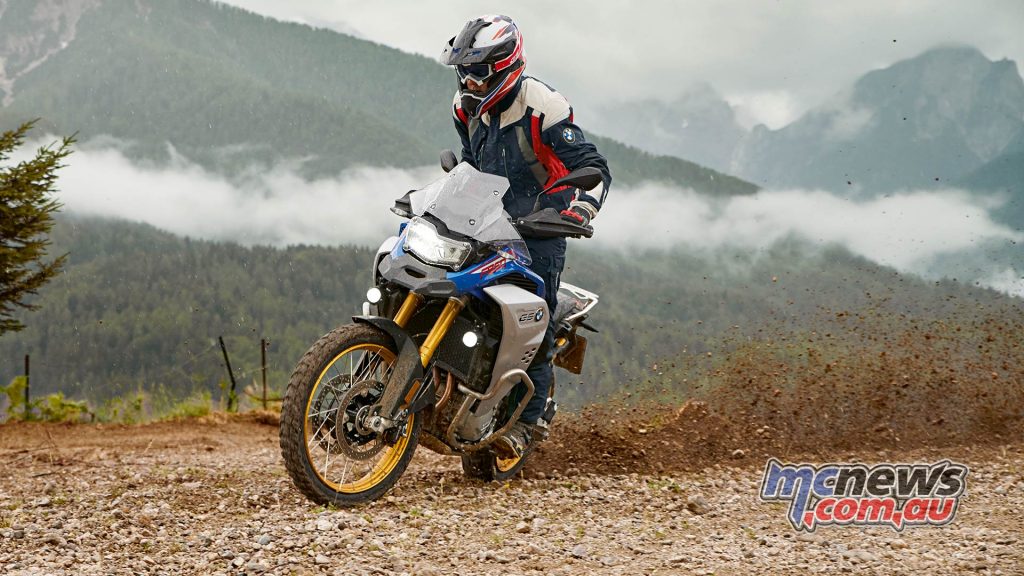
The engine displacement is now 853 cc (compared with 798 cc), resulting from a bore of 84 mm and stroke of 77 mm. The new F 850 GS Adventure generates 70 kW (95 hp) at 8250 rpm and develops a maximum torque of 92 Nm at 6250rpm. In particular, the increased torque results in improved pulling power, with a claimed top speed of 197 km/h.
The two-cylinder in-line engine is installed transverse to the direction of travel and liquid-cooled. In contrast to the engines of the previous model, however, its crankshaft has a 90-degree journal offset and a 270/450 degree ignition spacing (previous model had a 0 degree crankshaft journal offset and a 360 degree ignition spacing).
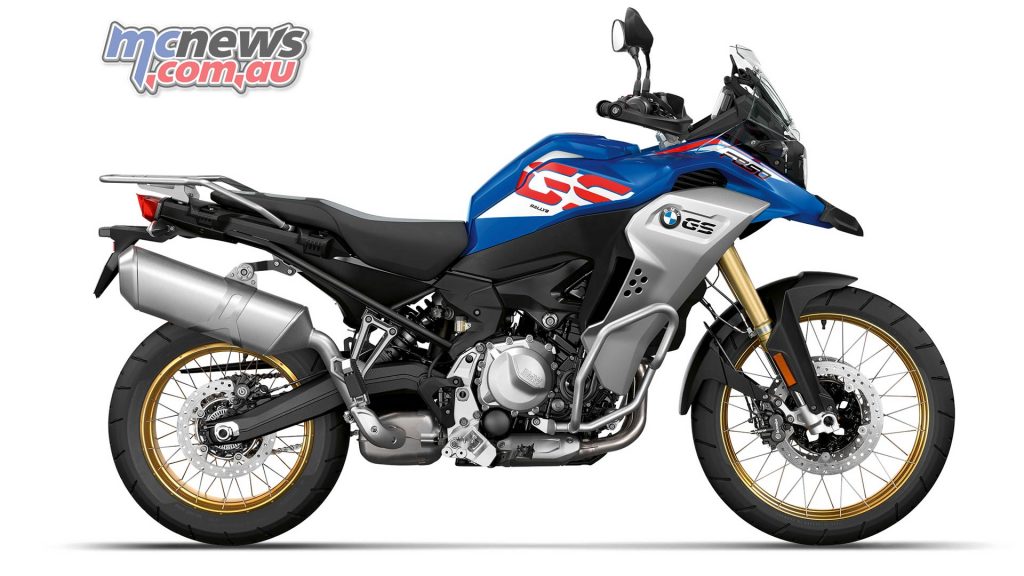
Two opposed counterbalance shafts help keep things smooth. These two opposed counterbalance shafts are arranged in front of or behind the crankshaft, a little below its axis, and are driven from the left of the crankshaft by the spur gears.
The engine of the new F 850 GS Adventure has dry-sump lubrication, which does not require a separate tank for engine oil. Any oil escaping from the main bearings is collected in a drain that is sealed off from the oil sump.
The bike’s off-road character is further reflected in the F 850 GS Adventure’s underside protection, which protects the oil sump from any damage.
The cylinder head of the new F 850 GS Adventure contains two rotating overhead camshafts driven by a toothed belt, which operates four valves per cylinder by means of light fixed-speed rocker arms. The timing chain drive is on the right-hand side of the engine.
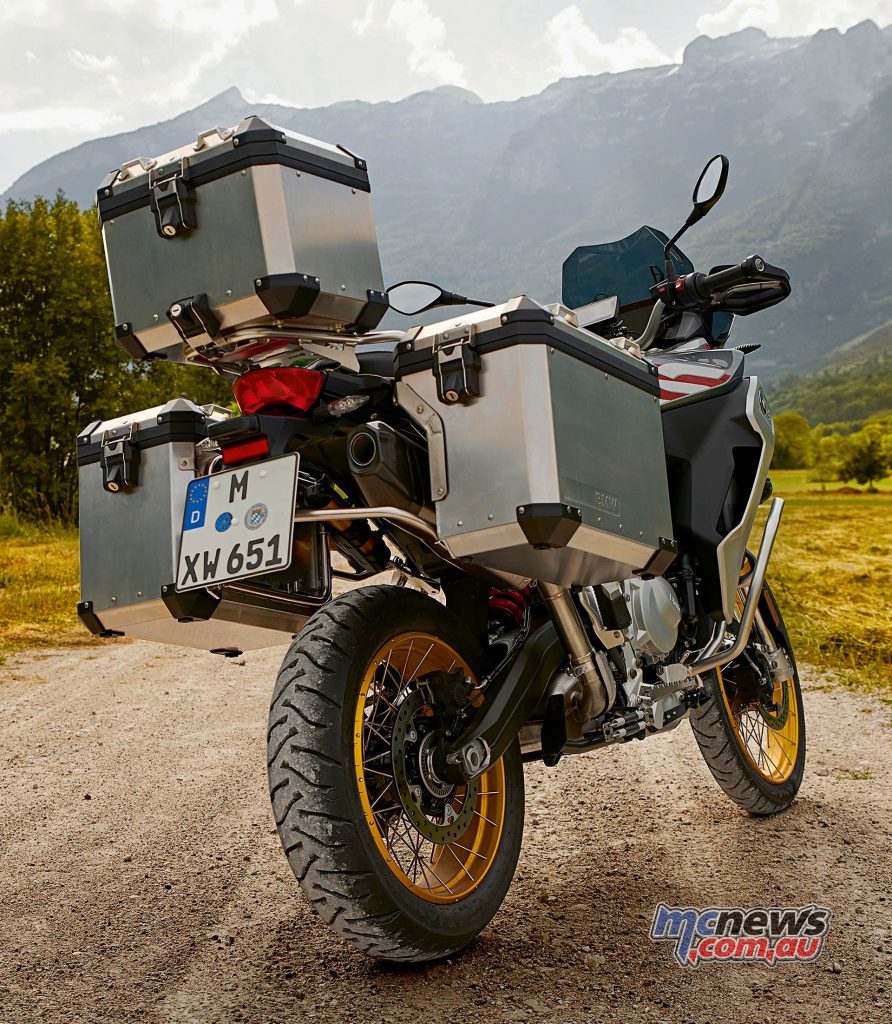
The valve angles are 11.2 degrees on the intake side and 13.3 degrees on the exhaust. The valves have a plate diameter of 33.5 mm (intake) and 27.2 mm (outlet). The compression ratio is 12.7:1.
Carburation is by means of intake pipe injection with next-generation BMS engine control. The rider’s control signals passed directly by a sensor on the throttle grip via an e-gas system to the motor controller, which regulates the angle of opening of the throttle valves.
The power transmission of the new F 850 GS Adventure has also been subjected to complete re-engineering. The primary drive arrangement on the right-hand side of the engine is responsible for transmitting the torque from the crankshaft to the clutch by means of spur gears. This is now designed as a slip-assist wet clutch.
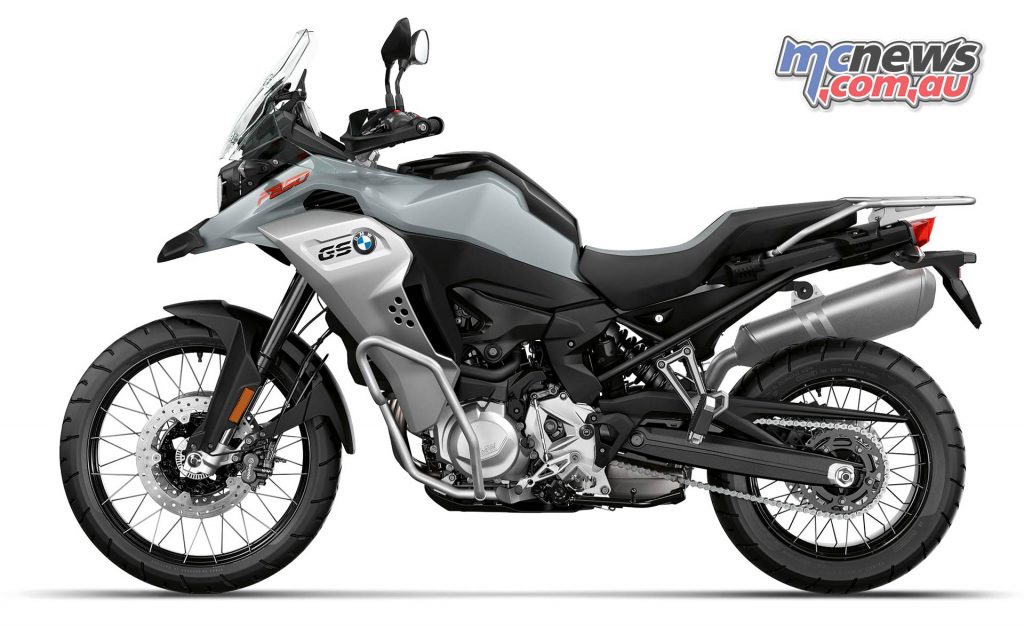
The newly engineered six-speed gearbox now transfers the torque with an optimised transmission ratio spread to the secondary drive on the left (formerly right), in the form of an X-ring chain. For fast up and down gear shifting without using the clutch, BMW Motorrad now offers the Shift Assistant Pro, available as optional equipment ex works.
Positioning the secondary drive on the left-hand side of the motorcycle, has made it possible to move the stainless steel exhaust system of the new F 850 GS Adventure to the right. This has advantages when the rider manoeuvres the motorcycle by hand, which is usually done from the left-hand side. The F 850 GS Adventure can also be fitted with an HP muffler with a sporty design, as optional equipment ex works.
The F 850 GS Adventure comes with the two riding modes “Rain” and Road” and ASC automatic stability control, to ensure a high degree of rider safety.
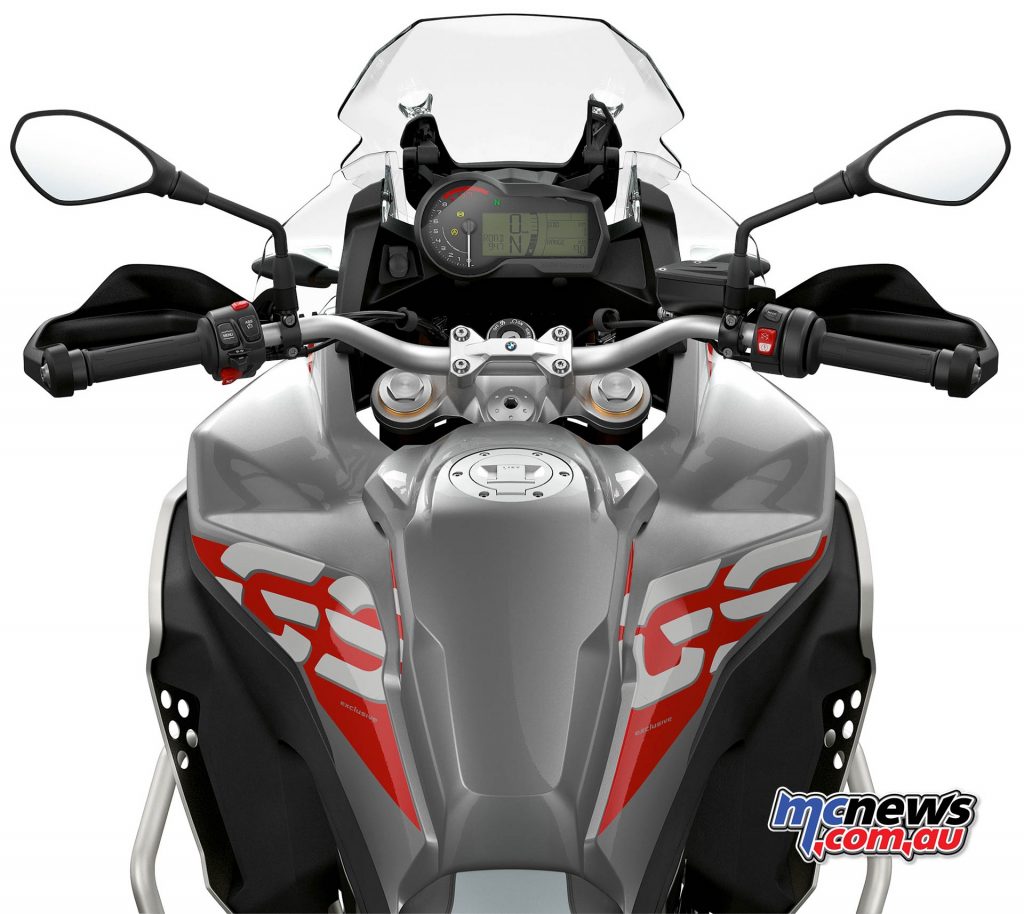
In “Rain” mode, the throttle response is configured to be soft, while the control characteristics of the ASC or DTC and ABS or ABS Pro are based on wet and slippery road surfaces. In “Road” mode, the engine permits optimum throttle response, while the ABS and ASC control systems are configured for ideal performance on all roads.
The F 850 GS Adventure can also be equipped with the “Pro riding modes” option as optional equipment ex works. It features the riding modes “Dynamic” and “Enduro” as well as the DTC dynamic traction control and the curve-optimised ABS Pro with dynamic brake light.
Ambitious enduro riders can tap into the full off-road performance in “Enduro Pro” mode. This riding mode is configured for the use of lugged tyres and is activated by a specially coded plug. With “Enduro Pro” the rider can individually configure and combine characteristics such as throttle response, DTC and ABS Pro. Here too Dynamic ESA is modified for offroad use and is set to the Enduro value.
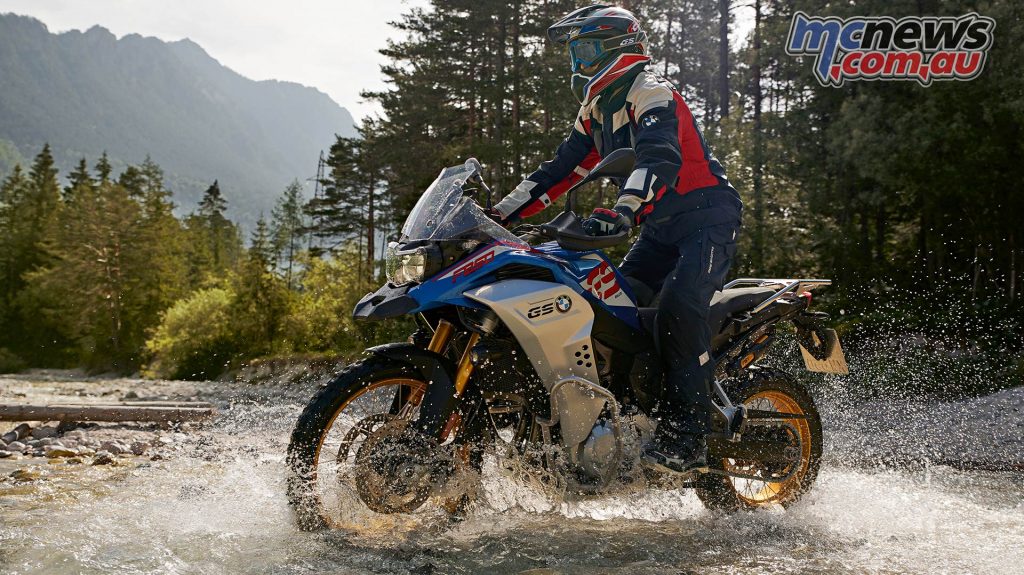
Updated chassis for road and dirt
The bridge frame developed for the new F 850 GS Adventure integrates the two-cylinder in-line engine as a self-supporting element and is made of deep-drawn sheet metal parts that are welded together. The new frame in monocoque design has greater torsional stiffness than the predecessor model with tubular steel space frame.
The new frame concept also involved a repositioning of the fuel tank and the 23-litre tank in the new F 850 GS Adventure is now located in the classic position between the seat and steering head, for optimising wheel load fluctuations and overall centre of gravity.
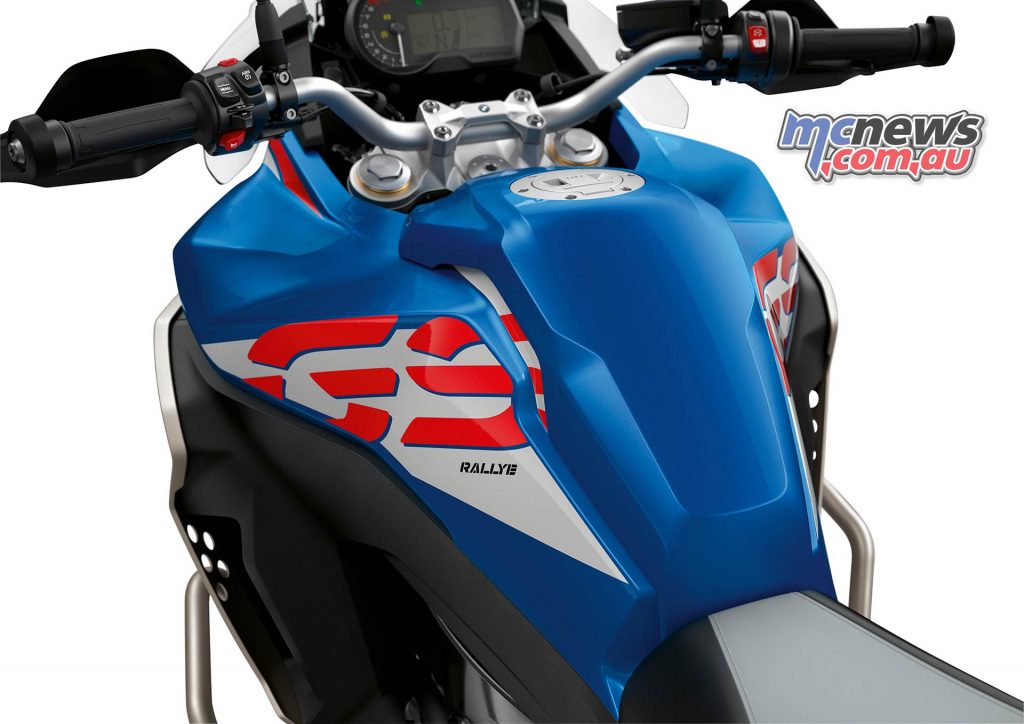
The avoidance of aluminium as a material was due to the tough conditions in which an enduro vehicle often finds itself. Significant benefits are offered by steel and the design of the new main frame.
The new F 850 GS Adventure has also undergone optimisation in terms of suspension geometry, with a flatter steering head in comparison to the previous model, as well as greater castor at the wheels.
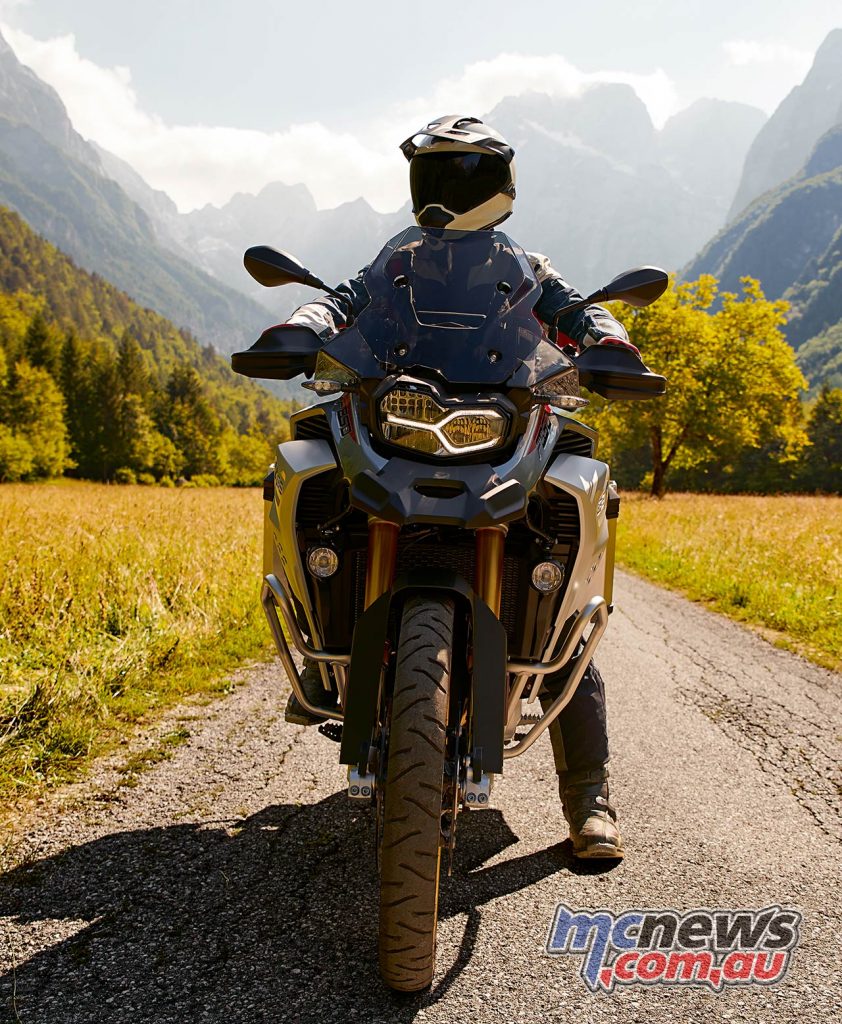
F 850 GS riders will also benefit from new wheel guides and spring shock absorber elements. Front wheel guidance is in the form of a new upside-down fork with 43mm slide tube diameter and 230 mm of spring travel (210 mm when lowered). The slider tubes are protected from stone impacts by plastic guards that are integrated in the front wheel cover.
Rear wheel control takes the form of a double-sided aluminium swinging arm and directly linked central spring strut with travel-dependent damping, which also has an adjustable spring base and rebound stage damping that can be adjusted to suit personal requirements. Spring travel distance is 215 mm (195 mm when lowered).
The BMW Motorrad dynamic ESA electronic suspension is available as optional equipment, offering a dynamic riding experience, where rider comfort and touring suitability of the new F 850 GS Adventure can be increased even further.
Dynamic ESA does not function as a standalone system but communicates with the other control systems, such as ABS / ABS Pro and ASC or DTC. The Dynamic ESA is also linked with the riding modes “Rain”, “Road”, “Dynamic”, “Enduro”, and “Enduro Pro”.
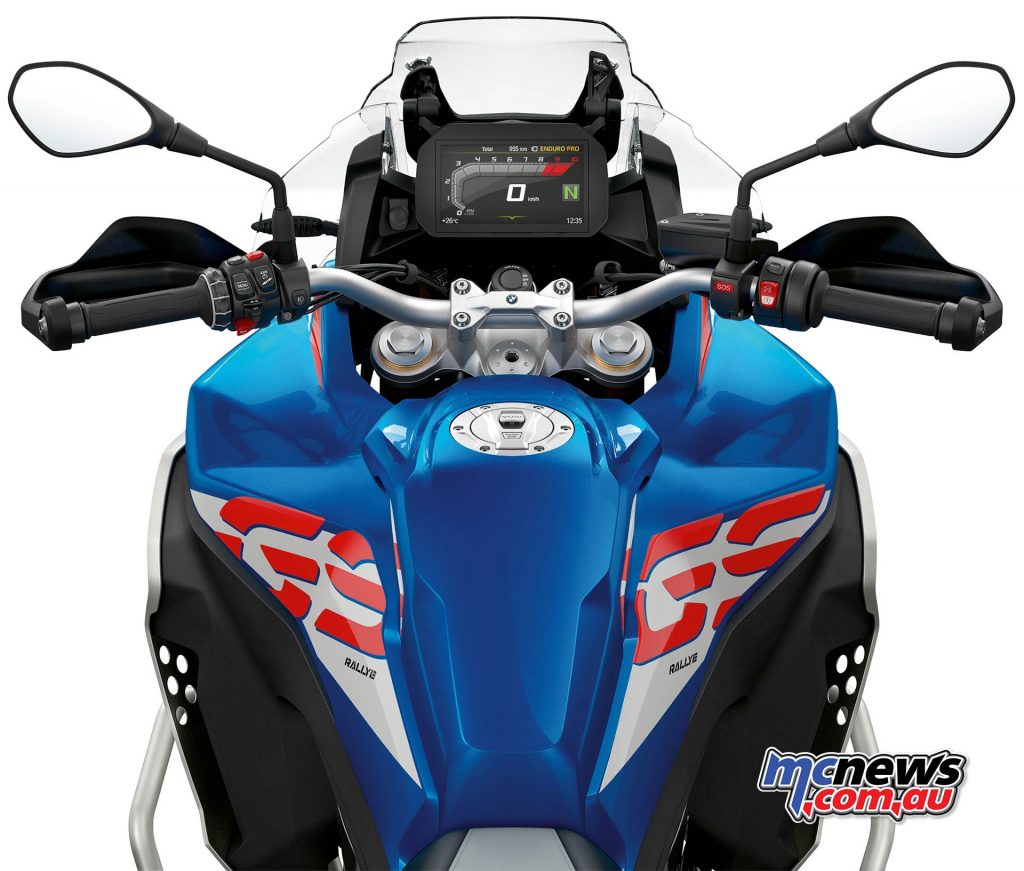
The F 850 GS Adventure is fitted with cross-spoke wheels with aluminium rims sized 2.15 x 21 at the front and 4.25 x 17 at the rear. The 21-inch front wheel favoured for sports-oriented offroad use as this grants high riding stability thanks to the larger gyroscopic forces, offering distinct advantages on loose ground.
The F 850 GS Adventure is also equipped with enduro street tyres as standard. It has tubeless tyres sized 90/90-21 at the front and 150/70-17 at the rear. More aggressive off-road specific tyres can be ordered as free optional equipment ex works.
Dual 305 mm discs are clamped by two-piston floating calipers. A single disc brake with a diameter of 265mm is fitted to the rear wheel with a single-piston floating caliper. The bike is fitted as standard with BMW Motorrad ABS, which the rider can also deactivate.
Further safety enhancing features for motorcycles are available in the form of the Pro riding modes optional equipment, ABS Pro functions, and a dynamic brake light – currently still limited to the EU and ECE region.
ABS Pro goes one step further than the BMW Motorrad ABS by offering increased safety when braking on bends in that ABS-supported braking is permitted in banking position. In the riding modes “Rain” and “Road”, ABS Pro is dimensioned for road use and moderate to low frictional values, plus optimum braking stability.
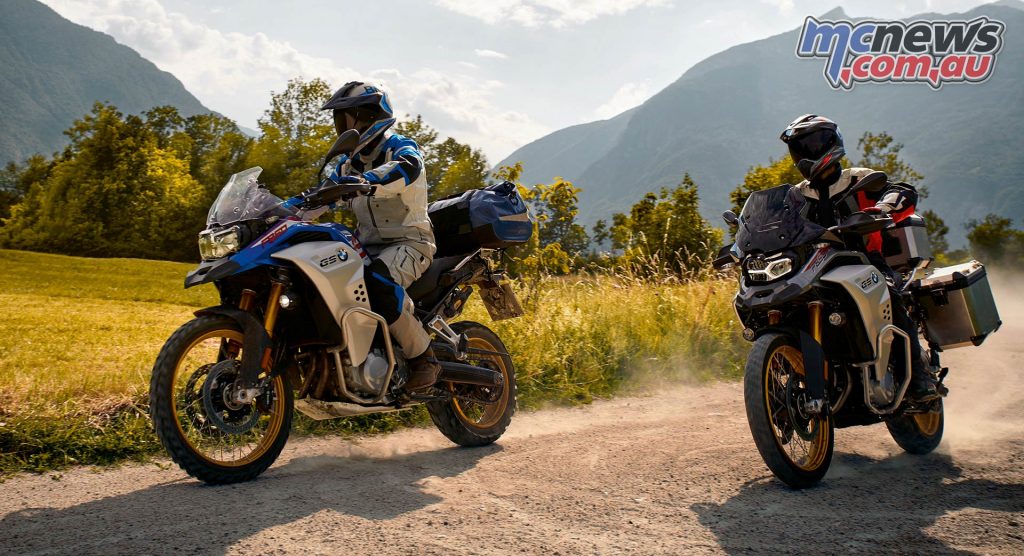
BMW Motorrad electronics
An LED headlamp is now offered as a standard feature on the new F 850 GS Adventure, and in addition to this, aLED daytime riding light is available as an optional equipment item.
The new LED headlamp lights up the road with a beam that is bright and offers strong clarity, also ensuring better visibility in traffic. The F 850 GS Adventure is also equipped with a completely new instrument cluster design, consisting of an analogue tachometer and a multifunctional display, alongside a number of control lamps.
New optional equipment known as Connectivity, includes a 6.5 inch full-colour TFT display. In conjunction with integrated operation via the BMW Motorrad multi-controller, it gives the rider quick access to vehicle and connectivity functions.
As is already the case with other BMW Motorrad models, the Keyless Ride system is available as optional equipment ex works and replaces the conventional ignition/steering lock in the new F 850 GS Adventure. The steering lock, ignition, fuel filler flap and anti-theft device are all activated by the transponder integrated in the vehicle key, which transmits a wireless signal with a frequency specific to the vehicle.
Design and Ergos
A high-positioned air intake, ample spring travel and ground clearance, functionally designed surfaces and a precise panel alignment underline the robust offroad attributes of the new middle class GS Adventure.
Like the big GS boxer Adventure it’s appearance is authentic, with iconic design features such as the asymmetric headlamp and the GS typical flyline clearly identify it as a member of the BMW Motorrad GS family. Starting from the front “beak” of the GS, the flyline extends over the fuel tank and seat to the rear, which is considerably more narrow in design that the predecessor model.
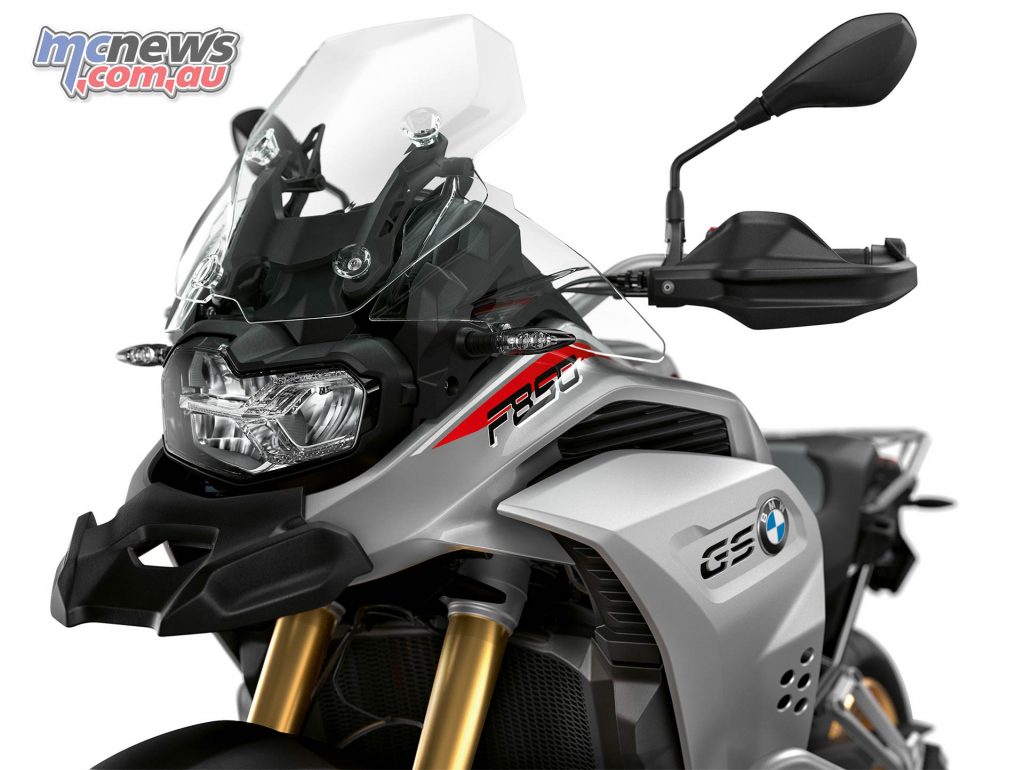
The new F 850 GS Adventure’s offroad suitability is also increased thanks to the new design of the fuel tank/seat area without any edges or corners. This is advantageous above all when riding offroad in a standing position. Conified 15mm higher handlebars, also ensure an even more comfortable seated position, while adjustable hand levers for the clutch and front brake enable the rider to choose his own setup.
Wider off road-optimised enduro footrests improve the bike’s off-road riding capabilities, with an adjustable foot brake lever insert for riding offroad in a standing position. An adjustable shift lever rounds off the ergonomic adjustment package.
An optimised inner leg curve length, numerous available seat heights, and a refined ergonomic triangle around the handlebars, seat bench and footrests also ensure a ride suitable for a broad range of riders. Compared to the predecessor model the standard seat height has been reduced by 15mm to 875mm. The minimum seat height of 815mm can be reached by lowering the suspension and installing a lower seat bench (optional equipment ex works).
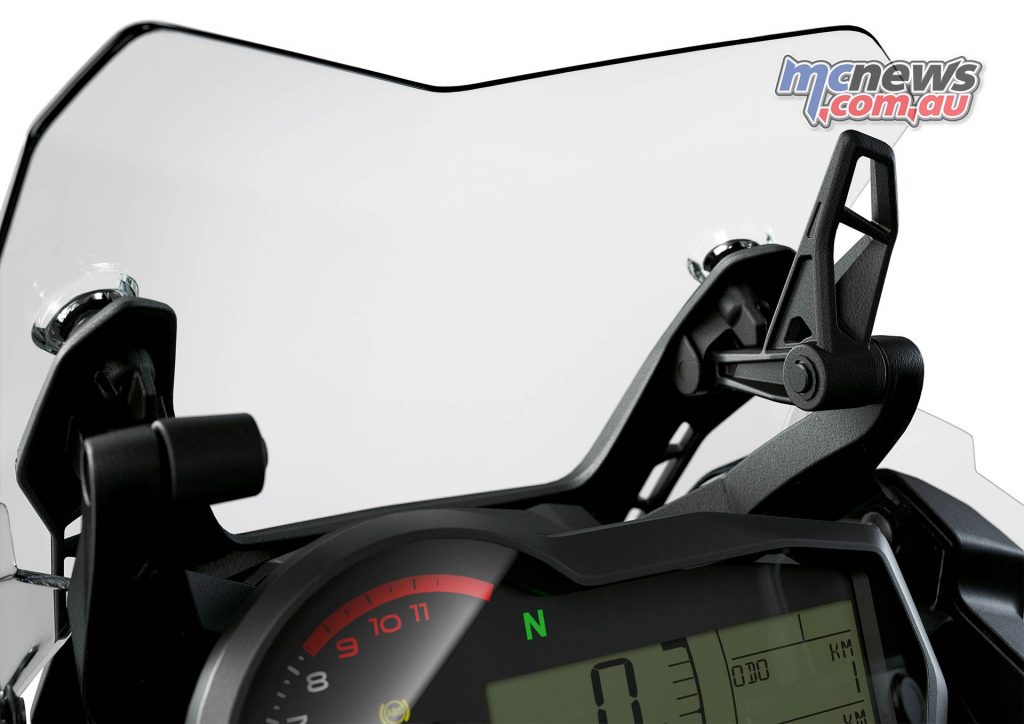
In addition wind and weather protection was optimised to make long-distance riding even more comfortable, with a height-adjustable touring windshield as well as two side wind deflectors as standard. The touring windshield of the F 850 GS Adventure can be adjusted in two positions improving wind and weather protection significantly. This is also optionally available for the F 850 GS.
Three dynamic colour and three style variations give the new F 850 GS Adventure its individual and characteristic features. The painted parts of both models have been deliberately kept to a minimum. They are located in the upper area of the motorcycle, where they form the interface between the rider and the motorcycle. The lower area of the motorcycle and the GS “beak’, on the other hand, are in black, to underline its offroad character.
2019 BMW F 850 GS Adventure variants & colours
- BMW F 850 GS Adventure Rallye – Lupinblau metallic
- BMW F 850 GS Adventure Exclusive – Granitgrau metallic
- BMW F 850 GS Adventure – Icegrey uni
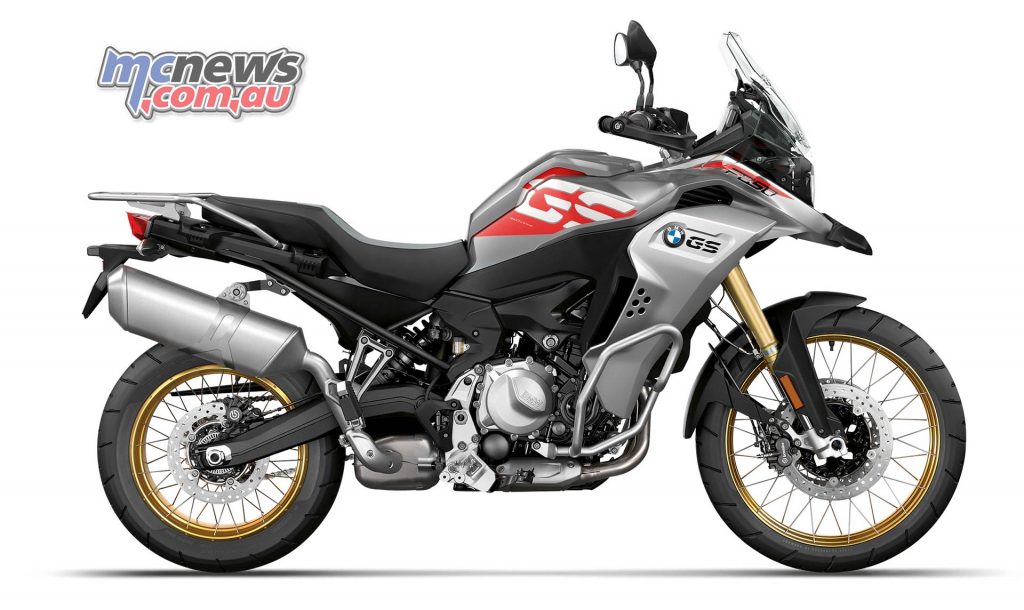
| 2019 BMW F 850 GS Adventure | |||
Engine | |||
| Capacity cc | 853 | ||
| Bore/stroke mm | 84 x 77 | ||
| Output kW/hp | 70/95 | ||
| At engine speed rpm | 8,250 | ||
| Torque Nm | 92 | ||
| At engine speed rpm | 6,250 | ||
| Type | Water-cooled 2-cylinder 4-stroke engine with four rocker arm operated valves per cylinder, two overhead camshafts and dry sump lubrication | ||
| Compression | 12.7/1 | ||
| Fuel | Premium unleaded 95 RON (option: 91 (RON) | ||
| Valve Control | DOHC (double overhead camshaft), rocker arms | ||
| Valves per cylinder | 4 | ||
| Throttle valves mm Ø | 48 | ||
| intake/outlet mm Ø | 33.5/27.2 | ||
| Engine control | BMS-O | ||
| Emission control | Closed-loop three-way catalytic converter, exhaust standard EU-4 | ||
Electrical system | |||
| Altinator W | 416 | ||
| Battery V/Ah | 12/10 | ||
| Headlamp | HalogenHigh beam/low beam: 12 V/55 W Halogen | ||
| Rear light | LED brake light/rear light | ||
| Starter K/W | 0.9 | ||
Power transmission | |||
| Clutch | Wet clutch with anti-hopping function, hydraulically activated | ||
| Transmission | Constant mesh 6-speed gearbox | ||
| Primary ratio | 1.821 | ||
| I | 2.833 | ||
| II | 2.067 | ||
| III. | 1.600 | ||
| IV. | 1.308 | ||
| V | 1.103 | ||
| VI | 0.968 | ||
| Secondary drive | Chain | ||
| Secondary ratio | 2.588 | ||
Suspension | ||||
| Frame construction type | Steel bridge frame in monocoque design, load-bearing engine | |||
| Front wheel control | USD fork Ø 43 mm | |||
| Rear wheel control | Aluminium double-sided swing arm, directly mounted central spring strut (F850 GS: Travel-dependent damping),spring rest hydraulically adjustable, rebound damping adjustable (Option: Dynamic ESA) | |||
| Spring travel, front/rear mm | 230/215 | |||
| Castor(unladen weight according to DIN) mm | 124.6 | |||
| Wheelbase(unladen weight according to DIN) mm | 1593 | |||
| Steering head angle(unladen weight according to DIN) ° | 62 | |||
| Front Brakes | Hydraulically activated twin disc brake, Ø 305 mm, 2-piston floating caliper | |||
| Rear Brakes | Hydraulically activated single disc brake, Ø 265mm, 1-piston floating caliper | |||
| ABS | BMW Motorrad ABS as standard, disengageable | |||
| Front Wheels | Cross-spoke 2.15 x 21” | |||
| Rear Wheel | Cross-spoke 4.25 x 17″ | |||
| Front Tyres | 90/90/21 | |||
| Rear Tyres | 150/70 R17 | |||
Dimensions and weights | ||||
| Total length mm | 2,300 | |||
| Total width including mirrors mm | 939 | |||
| Seat height | 875(OE low seat 835) (OE lowering 815)(OE DSB lowering 860) (Accessory: Rallye SB seat 890) | |||
| Empty weight according to DIN, kg road-ready | 244 | |||
| Permitted total weight kg | 455 | |||
| Fuel tank capacity l | 23 | |||
Performance figures | ||||
| Fuel consumption (WMTC)l/100 km | 4.1 | |||
| CO2 g/km | 98 | |||
| Acceleration 0-100 km/hs | 3.8 | |||
| Top speed km/h | >197 |























